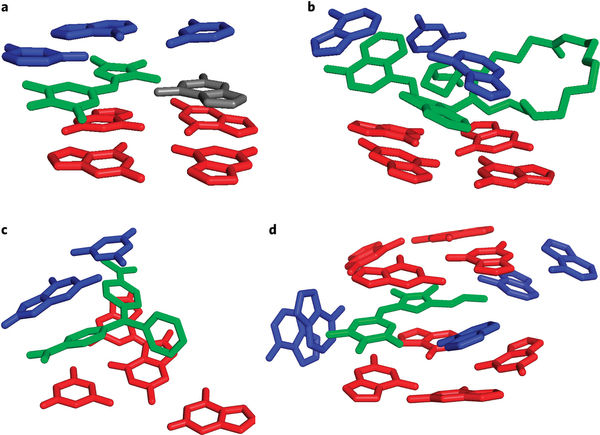RNA imaging: A tale of two G-quadruplexes (News and Views)
Aaron E. Engelhart
Nature Chemical Biology, 2017.
doi:10.1038/nchembio.2492
Publisher | ResearchGate | PubMed | Google Scholar | Free Readcube Link to Paper
This News and Views piece from our lab accompanies the the publication of a new fluorescent RNA imaging aptamer from Jaffrey and coworkers, termed Corn, as well as the crystal structure of the Corn aptamer, described in the same issue by Ferré-D’Amaré and coworkers. Corn is the next iteration of the Spinach and Broccoli aptamers. These first-generation aptamers bound small molecule fluorophores, DFHBI and DFHBI-1T, that mimicked the core of GFP. the Broccoli-DFHBI-1T and Spinach-DFHBI complexes were fluorescent, and enabled GFP-like RNA imaging. Corn binds to a mimic of the core of Red Fluorescent Protein, DFHO. The DFHO-Corn complex is both red-shifted and more photostable than Corn or Broccoli. This News and Views piece briefly summarizes the state of the fluorescent RNA imaging aptamer field and key structural features of known fluorescent imaging aptamers, with particular interest in the role of the G Quadruplex – a noncanonical RNA structure that frequently occurs in fluorescent aptamers, including Spinach and Corn.
Four fluorogenic aptamers have reported NMR or crystal structures. (a) Spinach (PDB ID 4TS2) contains a G-quartet (red) immediately adjacent to its fluorogenic ligand, DFHBI (green), which makes interactions with a coplanar guanine residue (gray). This binding pocket is capped by a base triple (blue). (b) Mango (PDB ID 5V3F) also contains a G-quartet (red), immediately adjacent to its fluorogenic ligand, TO1–biotin (green). This binding pocket is capped by several unpaired nucleobases (blue). (c) The malachite green aptamer (PDB ID 1Q8N) contains a tetrad that is not a G-quartet (red) immediately adjacent to its fluorogenic ligand, malachite green (green). This binding pocket is capped by a G–C base pair (blue). The commonality of a binding site containing a quartet (but not necessarily a G-quartet) suggests that this may be a common structural motif for fluorogenic aptamers. (d) Corn (PDB ID 5BJO) is a dimer that contains tandem G-quartets (red) from two protomers and unpaired adenosines (blue), which comprise the binding site for its fluorogenic ligand, DFHO (green).

